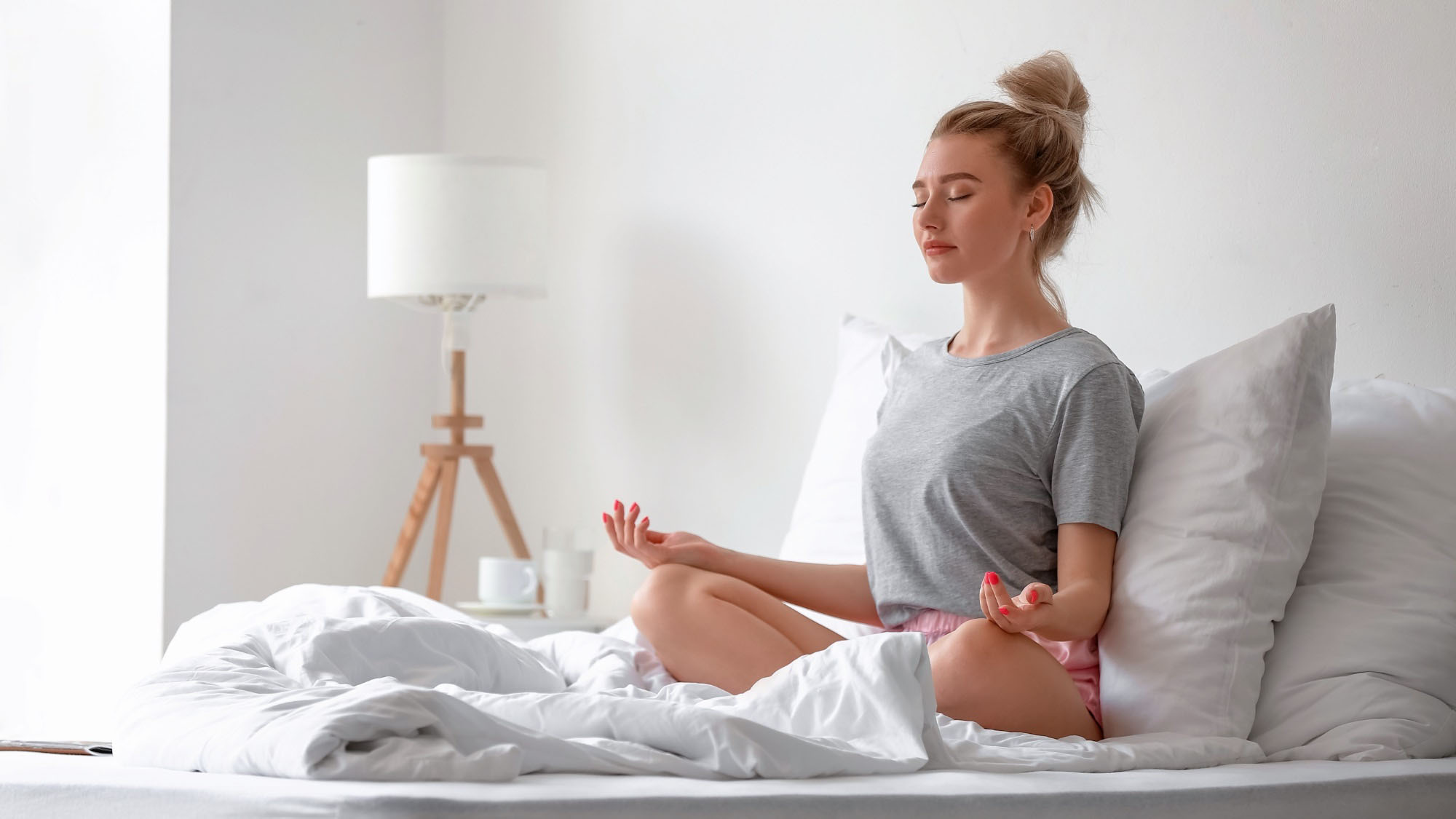The 7 best breathing exercises for sleep — fall asleep faster, easier and for longer
Looking for breathing exercises that work? These methods will ease sleep anxiety to help you drop off faster

Lying awake staring at the ceiling is frustrating. However, the best breathing exercises for sleep are designed to slow and regulate your breath, helping you to fall asleep faster and boost your chances of sleeping through the night.
Of course, sleeping on the best mattress for your body and sleeping position is an essential step to improving your overall sleep quality. But as an estimated 1 in 3 of us suffer from insomnia, adopting a tried and tested breathing method to incorporate into your nightly routine is good sleep hygiene practice.
To coincide with Sleep Awareness Week 2024, we have rounded up the seven best breathing techniques designed to help you overcome anxiety, stress and racing thoughts at bedtime and improve your overall sleep quality.
Nectar Mattress: up to 40% off at Nectar Sleep
During Sleep Awareness Week, you can save up to 40% on memory foam and hybrid mattresses at Nectar Sleep. We rate the Nectar Memory Foam as the best memory foam mattress for most sleepers with a smaller budget seeking a breathable all-foam bed that reduces aches and pains. A queen is reduced to $649 in the US, while you can buy a double size for £600 with a free bedding bundle in the UK. You'll also get a lifetime warranty and year's sleep trial.
7 best breathing exercises for better sleep
1. The 4-7-8 method
Adapted from traditional yogic breathing techniques, the 4-7-8 method aims to help reduce anxiety and encourage rhythmic, meditative breath flow to calm the mind in preparation for sleep. And, similarly to the 'alpha bridge' method, it’s fairly simple to master – simply breathe in deeply for four seconds, hold that breath for seven seconds, and breath out for eight seconds, and repeat the cycle around four times.
The key is to ensure each breath engages the diaphragm – essentially, take deep breaths that fill the lungs until you feel the diaphragm expand, and on the exhale, ensure your empty your lungs completely.
Here’s how to do it:
1. Breathe in deeply for four seconds until you feel your diaphragm expand.
2. Hold that breath for seven seconds.
3. Exhale slowly for eight seconds.
4. Repeat up to four times
Get instant access to breaking news, the hottest reviews, great deals and helpful tips.

2. The body scan technique
Grounded in mindfulness practice, the body scan technique doesn’t just focus on breathing, but some visualisation too, and it can take a little longer to cycle through than the other methods mentioned here.
But by mentally scanning different localised areas of the body, it’s a great way to pinpoint any areas where you might be holding tension and release that tension. Studies show practising mindfulness techniques like this can help you fall asleep too
Here’s how to do it:
1. Lie down, take some deep breaths
2. Starting at the crown of your head, notice how it feels, and if there is any pain, tension or stress you could be holding there.
3. Breathe deeply and sit with the feeling and breathe deeply for up to a minute.
4. Then let that feeling pass.
5. Next scan your neck, employing the same technique.
6. Gradually move down your body, scanning your shoulders, right arm and then hand, left arm and then hand.
7. End at your right toes and left toes, so you’ve scanned your whole body.
3. The Military Sleep Method
Originally developed in WW11 to help fighter pilots remain calm in combat situations, the military method is designed to help release the body and mind from ‘fight or flight’ mode, helping your heart rate slow down by flooding your blood with carbon dioxide. It’s gone viral on TikTok, with views clocking up over 8 million.
And it’s little wonder, devotees claim that, with practice, it can help you fall asleep in a couple of minutes. The process involves relaxing your face, tongue, jaw, then shoulders, hands and fingers. Then it’s all about breathing in deeply and allowing your legs and feet to relax. Finally, some visualisation comes into play – as you breath in and out slowly, visualise yourself on a boat on a calm lake as you drift off.
Here’s how to do it:
1. Allow your face, jaw and tongue to relax.
2. Let your shoulders drop, then relax hands and fingers.
3. Breathe out deeply to relax your chest.
4. Let legs and feet relax.
5. Exhale and inhale deeply then visualise yourself lying on a boat on a calm lake while you do so.
4. Belly breathing
During our waking hours, most of us take fairly shallow, rapid breaths, which can heighten feelings of anxiety – none of which are conducive to a good night’s sleep. There are several studies that show belly or diaphragmatic breathing has a positive impact when it comes to reducing symptoms of anxiety, which is essential for falling asleep quickly.
Belly breathing is one of the simplest breathing techniques and it can help promote feelings of relaxation and calm racing thoughts at bedtime because it encourages us to draw air deep into our diaphragm, which naturally slows the breath right down.
Here’s how to do it:
1. Lying on your back, place one hand on your belly and one on your chest.
2. Inhale deeply and the hand on your belly should rise whilst the one on your chest remains still.
3. Exhale and the hand on your belly should drop whilst the one on your chest stays still.
4. Repeat 20 times.
5. Box breathing
US Navy Seals use box breathing to help them regain control of their breath and release tension following intense combat situations. It’s designed to relax but also provide mental clarity too, which can be useful if you’re prone to lying awake worrying or ruminating. Navy Seals practice the technique for several minutes at a time, and it can be done anywhere to find some calm during a stressful situation.
Here’s how to do it:
1. Lie down and inhale deeply for four seconds.
2. Hold that breath for four seconds
3. Exhale for four seconds through your mouth.
4. Repeat.

6. Moon breathing
If you suffer from anxiety, moon breathing — also known as alternate nostril breathing — is designed to help released those feelings. According to one study, it does this by helping to calm the nervous system, which can have a positive impact in helping you fall asleep.
But rather than just involving breathing like many of the other exercises, with this method, you physically alternate pressing a finger against each side of your nose to close off that nostril in line with your breath.
Here’s how to do it:
1. Exhale through both nostrils
2. Close off your right nostril and as you do so, inhale with your left.
3. Before exhaling, close off your left nostril and exhale with your right.
4. Close off your right then exhale with your left.
5. Repeat for a few minutes
7. The counting method
We’ve all heard of counting sheep, but in reality, there is some science behind counting yourself to sleep — but it’s not about mindlessly counting animals. Instead, it’s important to align your counts with your inhales and exhales, to help focus and deepen the breath to develop a relaxing rhythm.
The counting part keeps you focussed and stops your mind from ruminating. The NHS advises breathing in as deeply as possible as you count to five, and then exhaling for five seconds, and repeating.
Here’s how to do it:
1. In bed, inhale slowly, as deeply as you can, while you count to five.
2. Exhale slowly, emptying your lungs as much as possible, as you count to five again.
3. Repeat for a few minutes.
How to use breathing techniques in your bedtime routine
The key with breathing techniques is to practise them as often as possible, ideally each night, so they become second nature. At first, you might find yourself overthinking each step and berating yourself if you can’t get the hang of it or hold your breath for the recommended time. It can be equally as maddening if your mind wanders.

If that happens, rather than feeling frustrated, acknowledge the thought you’ve just had. Then let it go and then resume the breathing method where you left off, or start again. It’s a case of trial and error too there are seven methods to try here, it’s worth experimenting with them all.
Once you find one or two that help, you'll soon find that as you begin your breathing technique, it’s a cue for your body to wind down and signify that sleep is imminent.

Bethan is a freelance journalist, brand consultant and copywriter, specialising in beauty, fashion, wellbeing, and health. She has over 17 years' experience working across print and digital platforms on national weekly, monthly and bi-monthly magazines, including Stylist online, Refinery29, Elle Australia, Grazia Australia, OK!, The Sunday Mirror, The Metro, Stella and Telegraph online, and more. Bethan has a keen interest in sleep and, crucially, how she somehow can get more of it.


